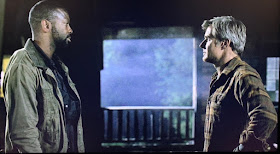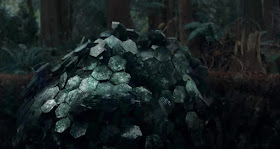Thursday, May 27, 2021
The Battlestar Galactica
Tuesday, May 25, 2021
Falling Skies S1 E7: Sanctuary (Part 2)
Friday, May 21, 2021
She Blinded Me With Science-Fiction Part 2
And so we continue with some short takes with Part 2 of our She Blinded Me With Science-Fiction series. What to see and what to miss.
The Walking Dead: World Beyond (2020-present). Spin-offs are a tricky business. It's challenging to consider if any have ever bested their parent series. Most would argue the original Stargate SG-1 (1997-2007) is the best of the three. Stargate Atlantis (2004-2009) and Stargate Universe (2009-2011) are both worthy entries in the franchise and some would try and argue best the original in some aspects. The same would hold true for the original Star Trek with proponents arguing on behalf of Star Trek: The Next Generation (1987-1994). Is anyone with me for Breaking Bad (2008-2013) spin-off Better Call Saul (2015-2022).
On the other side of the pond, Doctor Who (1963-present) spawned a couple of entries. The forgettable K-9 (1981, 2009-2010), Torchwood (2006-2011) and even The Sarah Jane Adventures (2007-2011) starring the late and lovely Elisabeth Sladen.
Like the latter, there is something kind of cutesy, teen-friendly, mindlessly pointless and rather vapid about this third entry in The Walking Dead franchise. It's even been referred to as "Woke Beyond" by some critics. The original is hands down the best and in no jeopardy of drawing any close comparisons. Fear The Walking Dead (2015-present) has been formidable and at times enjoyed some terrific entries, but for consistency, story and character simply doesn't compare to the original. The first season of FTWD was generally excellent.
TWD: WB is akin to TWD-lite. Kudos for an attempt at something new, but dialogue, teen characters, plot all fall flat. The series lacks real energy, suspense (much of the time), and the Empties (the Walkers in this series) are even incompetent at eating flesh. With the snowflake generation doing everything in its power to avoid killing the empties it's a wonder they succeed in surviving at all. These kids are asking for it. It's astounding how successful they are at evading the grim reaper. Acting is generally unmemorable despite the mostly likable, young group. There's very little inner conflict between the wayward children, which makes for a less than engaging slog and journey into the world beyond. Set in the future the series wisely tries something different from what has been established, but the result is underwhelming. The execution is lightweight and unworthy of the franchise. I viewed the entirety of Season One and there were more than a few cringeworthy moments and those aren't the kind of cringes you want when watching an epic franchise like TWD.
Scott Gimple, Matthew Negrete and the production team needed to execute this much better. From lackluster casting to poor writing to poor attention to detail, TWD: WB is far beyond what I expected. This is quite simply not very good.
Sadly, for every Better Call Saul there is an ugly misfire like TWD:WB. Unessential in the extreme for any Blu-Ray collection.
Tales From The Loop (2020-present). This is a positively immersive, beautiful, mesmerizing, hypnotic, dream-like, wondrous science fiction series. This is like a genuine throwback to science fiction found in the written word.
Based on the artwork of Swedish artist Simon Stalenhag (whose own hand is in the production), Tales From The Loop immerses us in his imaginative world while spinning eight (8) unique, distinctive, rewarding tales of science fiction all inextricably linked by the characters within its universe.
Some stories take old conventions (body-swapping, time travel) within the genre and spin some of the most delicate, beautiful tales of love. The allure wasn't necessarily immediate. Upon experiencing the first story I was not certain of this series' unique merits, but they slowly, steadily unraveled and revealed themselves with each new entry in a yarn like nothing I've quite enjoyed in some time. Tales From The Loop takes its time to enjoy the beautiful moments in cinema, an approach that would make an artist-director like Terrence Malick proud.
Perhaps it's no surprise the series sports impressive talents behind the camera, scripting and soundtrack. Wall-E's Andrew Stanton, Jodie Foster and Mark Romanek headline three entries alongside the minimalist melodies and compositions of Phillip Glass. If you know anything about these artists they are uncompromising in their abilities to entrance us with their visions. Each infuses a beauty and an emotional resonance within each story as a kind of visual poetry.
Tales From The Loop is like nothing you've seen in recent memory. It is such a vital work and even more important as art in a world that is more cold and calculating than ever thanks to social media and large-scale corporate technology. Tales From The Loop teaches us to merge both the natural world and technology with stories of the human heart. I was inspired and yet entranced by the beauty of this series.
Despite its science fiction back drop there is a simplicity within its complex story concepts to the point of longing for a simpler more traditional existence. We live in a chaotic, fleeting and often transient world. This series is a fine antidote to so much of the effect-heavy nightmares that pollute cinemas.
Tales From The Loop is essential for human beings who long for more humanity. One would have to lack heart not to feel something in this wondrous, magical, surreal, special place called The Loop. This is truly a fascinating detour away from our more frightening realities of late to a much more fantastical place. Essential for fans of science fiction with humanity. Hoping for a Blu-Ray arrival.
Into The Badlands (2015-2019). Drawing from science fiction, fantasy and martial arts, this wildly underrated series from AMC is entirely its own animal. Pulling its inspiration from the kind of energy mash-up that infused such projects as Crouching Tiger, Hidden Dragon (2000), John Wick (2014), The Matrix (1999) this is a sprawling sci-fi, action-heavy, martial arts drama. It's contents are diverse and often times riveting.
Into The Badlands, with all of its colorful set pieces and Wick-styled excitement populating the series in fits and starts, still tells a compelling journey story surrounding two characters in a struggle for self-discovery, one young and one older, surrounded by a terrific supporting cast on intriguing characters.
Daniel Wu is a surprising find for this fanatic and offers a compelling screen presence reminiscent of the wonderful Chow Yun Fat (both given to the influence and power of Hong Kong cinema).
Season One is a short six episode treasure trove of character and world-building, fine performances, production values and storytelling.
The AMC series arrived in 2015 following The Walking Dead (2010-present) Season Six and this writer, at the time, never really gave it a chance. Perhaps this was the result of all that exhaustive tension and zombie killing. Giving it a second look Into The Badlands has delivered pure escapist pleasures. The Walking Dead was a tough act to follow but Into The Badlands is equally violent and thrilling in its own right while being something entirely unique and fantastical for television.
I'm not sure people understood just how special this series was upon its arrival, but it could be sci-fi/fantasy/martial arts is a tough sell too. It's a thrilling drama in and of itself, but that really shouldn't be too surprising given its AMC stamp (of course there was The Walking Dead: World Beyond). The channel continues to deliver some of the very best in television. It may not be essential, but it's a fairly thrilling dramatic genre mash-up type enterprise for those looking for something different in the diverse science fiction universe. Nice three season set for the Blu-Ray collection but unessential.
Debris (2021-present). Debris is the latest to be mildly hailed, elevated and marginally compared to the highly influential The X-Files (1993-2018). Dark Skies (1996-1997) and Fringe (2008-2013) had followed in the latter's footsteps.
Fringe had promise, but ultimately faltered for me and at times became increasingly preposterous. Debris juggles its mysterious and thrilling ten episodes far better.
This may come as a surprise given the series was created by J.H. Wyman. Wyman penned 32 episodes of Fringe and directed two of its episodes including writing and directing that aforementioned series finale. Still, Wyman didn't create Fringe, that was the handiwork of J.J. Abrams, Alex Kurtzman and Roberto Orci.
Wyman's concept here is simply better science fiction. It leans more to the darker work found in The X-Files and for that it's all the better. Perhaps its a learning curve and growth, but Wyman's Debris rings more credibly within the parameters of its science fiction universe. In the real world UFO sightings and Pentagon information continues to pepper headlines regarding military contacts and these stories are astounding.
Debris is about, the scattered wreckage of an alien spacecraft and its impact and influence on humanity across the planet as it falls from space. Those discoveries and mysteries are chased by a member of the CIA and MI6 working in tandem with a number of questionable international players involved with competing agendas.
Debris is new, but out of the gate, it is a thrilling and captivating take on its concept and it largely works. This one comes recommended as essential for fans of science fiction or The X-Files and is more impressive and effective in its tone and approach than Wyman's aforementioned involvement with Fringe. Debris is an essentially noteworthy new arrival. It's an intriguing premise with long-term potential.



























































